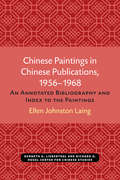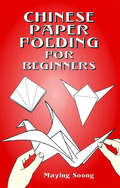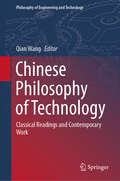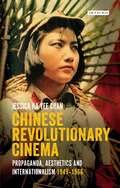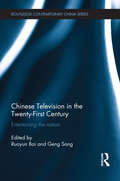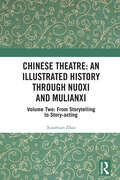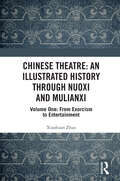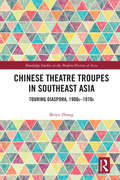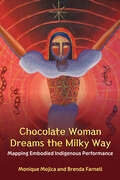- Table View
- List View
Chinese Paintings in Chinese Publications, 1956–1968: An Annotated Bibliography and Index to the Paintings (Michigan Monographs In Chinese Studies #6)
by Ellen Johnston LaingThis bibliography includes publications issued between 1956 and August 1968 that reproduce Chinese paintings now in Chinese public or private collections. The great majority of these publications were produced in Mainland China, Taiwan, Hong Kong, or Japan. Each publication included in the bibliography has been provided with a detailed physical description of the publication itself: the amounts of text , the number of plates in color and in monochrome, and a general evaluation of the quality of the reproductions. The title by which each work is referred to in the index is included at the end of each entry.
Chinese Paper Folding for Beginners (Dover Origami Papercraft Ser.)
by Maying SoongThough nowadays people usually refer to paper folding by its Japanese name, origami, the art most likely originated in China. Even today, youngsters in that country are taught this craft at a very early age by mothers and grandmothers.In this charming, instructive book, the author shares her knowledge of this rewarding craft by providing clear instructions and simple diagrams for folding gaily colored part hats, a pagida-shaped bookmark, toy boats made of waterproof paper, decorative candy boxes, a bird with wings that flap when its tail is pushed in and out, a Chinese fishing boat, a monkey, steamboats — even a three-piece living room set and other items of tiny furniture for a doll's house. All can be made without using scissors or paste, and projects are arranged from easiest to those requiring more skill.Children and adults alike will find this book fascinating and will be delighted by the imaginative works they're able to create from a single sheet of paper.
Chinese Philosophy of Technology: Classical Readings and Contemporary Work (Philosophy of Engineering and Technology #34)
by Qian WangThis book gathers essays that introduce the ideological advances in the philosophy of engineering and technology in contemporary China. It particularly focuses on China’s distinctive concepts and methods, revealing different views and academic debates to offer readers a comprehensive overview of this important field.The contributors present unique perspectives based on practical problems and traditional philosophy, examining such issues and concepts as axiology and theories of process, the difference between engineering activities and technology activities, and the core of the relationship between “Dao” and “Technique.”Other essays cover the ethics of technology, practical wisdom (phronesis) and practical reasoning, as well as creative concepts and methods concerning the philosophical problems in high technology, architectural technology, and technological innovation. The authors also consider more general issues in the field.This book compiles the relevant research achievements of Chinese scholars in various time periods. Some authors have revised and translated into English papers published in Chinese, while others present their research in English specifically for this study. An annotated bibliography of the major publications in the field completes this collection.
Chinese Revolutionary Cinema: Propaganda, Aesthetics and Internationalism 1949–1966 (International Library of the Moving Image (PDF) #48)
by Jessica Ka ChanEngaging with fiction films devoted to heroic tales from the decade and a half between 1949 and 1966, this book reconceives state propaganda as aesthetic experiments that not only radically transformed acting, cinematography and screenwriting in socialist China, but also articulated a new socialist film theory and criticism. Rooted in the interwar avant-garde and commercial cinema, Chinese revolutionary cinema, as a state cinema for the newly established People's Republic, adapted Chinese literature for the screen, incorporated Hollywood narration, appropriated Soviet montage theory and orchestrated a new, glamorous, socialist star culture. In the wake of decolonisation, Chinese film journals were quick to project and disseminate the country's redefined self-image to Asia, Africa and Latin America as they helped to create an alternative vision of modernity and internationalism. Revealing the historical contingency of the term 'propaganda', Chan uncovers the visual, aural, kinaesthetic, sexual and ideological dynamics that gave rise to a new aesthetic of revolutionary heroism in world cinema. Based on extensive archival research, this book's focus on the distinctive rhetoric of post-war socialist China will be of value to East Asian Cinema scholars, Chinese Studies academics and those interested in the history of twentieth-century socialist culture.
Chinese Revolutionary Cinema: Propaganda, Aesthetics and Internationalism 1949–1966 (International Library of the Moving Image (PDF))
by Jessica Ka ChanEngaging with fiction films devoted to heroic tales from the decade and a half between 1949 and 1966, this book reconceives state propaganda as aesthetic experiments that not only radically transformed acting, cinematography and screenwriting in socialist China, but also articulated a new socialist film theory and criticism. Rooted in the interwar avant-garde and commercial cinema, Chinese revolutionary cinema, as a state cinema for the newly established People's Republic, adapted Chinese literature for the screen, incorporated Hollywood narration, appropriated Soviet montage theory and orchestrated a new, glamorous, socialist star culture. In the wake of decolonisation, Chinese film journals were quick to project and disseminate the country's redefined self-image to Asia, Africa and Latin America as they helped to create an alternative vision of modernity and internationalism. Revealing the historical contingency of the term 'propaganda', Chan uncovers the visual, aural, kinaesthetic, sexual and ideological dynamics that gave rise to a new aesthetic of revolutionary heroism in world cinema. Based on extensive archival research, this book's focus on the distinctive rhetoric of post-war socialist China will be of value to East Asian Cinema scholars, Chinese Studies academics and those interested in the history of twentieth-century socialist culture.
Chinese Television and National Identity Construction: The Cultural Politics of Music- Entertainment Programmes (Media, Culture And Social Change In Asia Ser.)
by Lauren GorfinkelThis book examines music entertainment programmes on China Central Television, China's only national level television network, as well as on nationally-available provincial channels, exploring how such programmes project a nuanced image of China's identity and position in the world. It shows how the images presented - primarily to domestic audiences - are in step with China's party-state nationalism, and at the same time flexible and open to change as China's circumstances change. The book contextualises identity construction in the media by examining the development of television in China and the political struggles between provincial and national television stations, as well as by foregrounding the historical and contemporary role of musical culture in China's nation-building project. It discusses the portrayal of the majority Han Chinese, and of ethnic minorities and their music, which, the author argues, are shown as fitting with the party-state rhetoric of "a unitary multi-ethnic state". It also outlines how the Chinese of Greater China - Hong Kong, Taiwan, Macao and the overseas Chinese - are incorporated into a mainland centred Chinese identity. In addition, it shows how the performances of foreign personalities on the Chinese television stage emphasise foreigners' attraction to China, the uniqueness of the Chinese nation and Chinese civilisation, and the revitalised role of China in the world. Overall, the book demonstrates how the variations of Chinese identity fit with prevailing political ideologies in China and with the emerging theme of a China-centred world.
Chinese Television and National Identity Construction: The Cultural Politics of Music- Entertainment Programmes (Media, Culture And Social Change In Asia Ser.)
by Lauren GorfinkelThis book examines music entertainment programmes on China Central Television, China's only national level television network, as well as on nationally-available provincial channels, exploring how such programmes project a nuanced image of China's identity and position in the world. It shows how the images presented - primarily to domestic audiences - are in step with China's party-state nationalism, and at the same time flexible and open to change as China's circumstances change. The book contextualises identity construction in the media by examining the development of television in China and the political struggles between provincial and national television stations, as well as by foregrounding the historical and contemporary role of musical culture in China's nation-building project. It discusses the portrayal of the majority Han Chinese, and of ethnic minorities and their music, which, the author argues, are shown as fitting with the party-state rhetoric of "a unitary multi-ethnic state". It also outlines how the Chinese of Greater China - Hong Kong, Taiwan, Macao and the overseas Chinese - are incorporated into a mainland centred Chinese identity. In addition, it shows how the performances of foreign personalities on the Chinese television stage emphasise foreigners' attraction to China, the uniqueness of the Chinese nation and Chinese civilisation, and the revitalised role of China in the world. Overall, the book demonstrates how the variations of Chinese identity fit with prevailing political ideologies in China and with the emerging theme of a China-centred world.
Chinese Television in the Twenty-First Century: Entertaining the Nation (Routledge Contemporary China Series)
by Ruoyun Bai Geng SongThe past two decades witnessed the rise of television entertainment in China. Although television networks are still state-owned and Party-controlled in China, the ideological landscape of television programs has become increasingly diverse and even paradoxical, simultaneously subservient and defiant, nationalistic and cosmopolitan, moralistic and fun-loving, extravagant and mundane. Studying Chinese television as a key node in the network of power relationships, therefore, provides us with a unique opportunity to understand the tension-fraught and , paradox-permeated conditions of Chinese post-socialism. This book argues for a serious engagement with television entertainment. rethinking, It addresses the following questions. How is entertainment television politically and culturally significant in the Chinese context? How have political, industrial, and technological changes in the 2000s affected the way Chinese television relates to the state and society? How can we think of media regulation and censorship without perpetuating the myth of a self-serving authoritarian regime vs. a subdued cultural workforce? What do popular televisual texts tell us about the unsettled and reconfigured relations between commercial television and the state? The book presents a number of studies of popular television programs that are sensitive to the changing production and regulatory contexts for Chinese television in the twenty-first century. As an interdisciplinary study of the television industry, this book covers a number of important issues in China today, such as censorship, nationalism, consumerism, social justice, and the central and local authorities. As such, it will appeal to a broad audience including students and scholars of Chinese culture and society, media studies, television studies, and cultural studies.
Chinese Television in the Twenty-First Century: Entertaining the Nation (Routledge Contemporary China Series)
by Ruoyun Bai Geng SongThe past two decades witnessed the rise of television entertainment in China. Although television networks are still state-owned and Party-controlled in China, the ideological landscape of television programs has become increasingly diverse and even paradoxical, simultaneously subservient and defiant, nationalistic and cosmopolitan, moralistic and fun-loving, extravagant and mundane. Studying Chinese television as a key node in the network of power relationships, therefore, provides us with a unique opportunity to understand the tension-fraught and , paradox-permeated conditions of Chinese post-socialism. This book argues for a serious engagement with television entertainment. rethinking, It addresses the following questions. How is entertainment television politically and culturally significant in the Chinese context? How have political, industrial, and technological changes in the 2000s affected the way Chinese television relates to the state and society? How can we think of media regulation and censorship without perpetuating the myth of a self-serving authoritarian regime vs. a subdued cultural workforce? What do popular televisual texts tell us about the unsettled and reconfigured relations between commercial television and the state? The book presents a number of studies of popular television programs that are sensitive to the changing production and regulatory contexts for Chinese television in the twenty-first century. As an interdisciplinary study of the television industry, this book covers a number of important issues in China today, such as censorship, nationalism, consumerism, social justice, and the central and local authorities. As such, it will appeal to a broad audience including students and scholars of Chinese culture and society, media studies, television studies, and cultural studies.
Chinese Theatre: Volume Two: From Storytelling to Story-acting
by Xiaohuan ZhaoChinese Theatre: An Illustrated History Through Nuoxi and Mulianxi is the first book in any language entirely devoted to a historical inquiry into Chinese theatre through Nuoxi and Mulianxi, the two most representative and predominant forms of Chinese temple theatre. Volume Two is a continuation of the historical inquiry into Chinese theatre with focus shifted from Mulian storytelling to Mulian story-acting. Thus, this volume traces the historical trajectory of xiqu from Northern dramas to Southern dramas and from elite court theatre to mass regional theatre with pivotal forms and functions of Mulianxi examined, explicated and illustrated in association with the development of corresponding genres of xiqu. In so doing, every aspect of Mulianxi is considered not in the margins of xiqu but in and of itself. While this volume is primarily concerned with Mulianxi, references are also made to other forms of Chinese performing arts and temple theatre, Nuoxi in particular, as Mulianxi has been performed since the twelfth century as, or in company with, Nuoxi, to cleanse the community of evil spirits and epidemic diseases. This is an interdisciplinary book project that is aimed to help researchers and students of theatre history understand the ritual origins of Chinese theatre and the dynamic relationships among myth, ritual, religion and theatre.
Chinese Theatre: Volume Two: From Storytelling to Story-acting
by Xiaohuan ZhaoChinese Theatre: An Illustrated History Through Nuoxi and Mulianxi is the first book in any language entirely devoted to a historical inquiry into Chinese theatre through Nuoxi and Mulianxi, the two most representative and predominant forms of Chinese temple theatre. Volume Two is a continuation of the historical inquiry into Chinese theatre with focus shifted from Mulian storytelling to Mulian story-acting. Thus, this volume traces the historical trajectory of xiqu from Northern dramas to Southern dramas and from elite court theatre to mass regional theatre with pivotal forms and functions of Mulianxi examined, explicated and illustrated in association with the development of corresponding genres of xiqu. In so doing, every aspect of Mulianxi is considered not in the margins of xiqu but in and of itself. While this volume is primarily concerned with Mulianxi, references are also made to other forms of Chinese performing arts and temple theatre, Nuoxi in particular, as Mulianxi has been performed since the twelfth century as, or in company with, Nuoxi, to cleanse the community of evil spirits and epidemic diseases. This is an interdisciplinary book project that is aimed to help researchers and students of theatre history understand the ritual origins of Chinese theatre and the dynamic relationships among myth, ritual, religion and theatre.
Chinese Theatre: Volume One: From Exorcism to Entertainment
by Xioahuan ZhaoChinese Theatre: An Illustrated History Through Nuoxi and Mulianxi is the first book in any language entirely devoted to a historical inquiry into Chinese theatre through Nuoxi and Mulianxi, the two most representative and predominant forms of Chinese temple theatre. With a view to evaluating the role of temple theatre in the development of xiqu or traditional Chinese theatre and drama from myth to ritual to ritual drama to drama, Volume One provides a panoramic perspective that allows every aspect of Nuoxi to be considered, not in the margins of xiqu but in and of itself. Thus, this volume traces xiqu history from its shamanic roots in exorcism rituals of Nuo to various forms of ritual and theatrical performance presented at temple fairs, during community and calendrical festivals or for ceremonial functions over the course of imperial history, and into the twenty-first century, followed by an exploration of the scriptural origins and oral traditions of Mulianxi, with pivotal forms and functions of Nuoxi and Mulian storytelling, examined, explicated and illustrated in association with the development of corresponding genres of Chines performance literature and performing arts. This is an interdisciplinary book project that is aimed to help researchers and students of theatre history understand the ritual origins of Chinese theatre and the dynamic relationships among myth, ritual, religion, and theatre.
Chinese Theatre: Volume One: From Exorcism to Entertainment
by Xioahuan ZhaoChinese Theatre: An Illustrated History Through Nuoxi and Mulianxi is the first book in any language entirely devoted to a historical inquiry into Chinese theatre through Nuoxi and Mulianxi, the two most representative and predominant forms of Chinese temple theatre. With a view to evaluating the role of temple theatre in the development of xiqu or traditional Chinese theatre and drama from myth to ritual to ritual drama to drama, Volume One provides a panoramic perspective that allows every aspect of Nuoxi to be considered, not in the margins of xiqu but in and of itself. Thus, this volume traces xiqu history from its shamanic roots in exorcism rituals of Nuo to various forms of ritual and theatrical performance presented at temple fairs, during community and calendrical festivals or for ceremonial functions over the course of imperial history, and into the twenty-first century, followed by an exploration of the scriptural origins and oral traditions of Mulianxi, with pivotal forms and functions of Nuoxi and Mulian storytelling, examined, explicated and illustrated in association with the development of corresponding genres of Chines performance literature and performing arts. This is an interdisciplinary book project that is aimed to help researchers and students of theatre history understand the ritual origins of Chinese theatre and the dynamic relationships among myth, ritual, religion, and theatre.
Chinese Theatre Troupes in Southeast Asia: Touring Diaspora, 1900s–1970s (Routledge Studies in the Modern History of Asia)
by Beiyu ZhangA detailed account of the cultural history of the Chinese diaspora, with a focus on the performers and audiences who were involved in the making of Chinese performing cultures in Southeast Asia. Focusing on five different kinds of theatre troupes from China and their respective travels in Singapore, Bangkok, Malaya and Hong Kong, Zhang examines their different travelling experiences and divergent cultural practices. She thus sheds light on how transnational mobility was embodied, practised and circumscribed in the course of troupes’ travelling, sojourning and interacting with diasporic communities. These troupes communicated diverse discourses and ideologies influenced by different social political movements in China, and these meanings were further altered by transmission. By unpacking multiple ways of performing Chineseness that was determined by changing time-space constructions, this volume provides valuable insight for scholars of the Chinese Diaspora, Transnational History and Performing Arts in Asia.
Chinese Theatre Troupes in Southeast Asia: Touring Diaspora, 1900s–1970s (Routledge Studies in the Modern History of Asia)
by Beiyu ZhangA detailed account of the cultural history of the Chinese diaspora, with a focus on the performers and audiences who were involved in the making of Chinese performing cultures in Southeast Asia. Focusing on five different kinds of theatre troupes from China and their respective travels in Singapore, Bangkok, Malaya and Hong Kong, Zhang examines their different travelling experiences and divergent cultural practices. She thus sheds light on how transnational mobility was embodied, practised and circumscribed in the course of troupes’ travelling, sojourning and interacting with diasporic communities. These troupes communicated diverse discourses and ideologies influenced by different social political movements in China, and these meanings were further altered by transmission. By unpacking multiple ways of performing Chineseness that was determined by changing time-space constructions, this volume provides valuable insight for scholars of the Chinese Diaspora, Transnational History and Performing Arts in Asia.
Chinese Traditional Theatre and Male Dan: Social Power, Cultural Change and Gender Relations (Routledge Advances in Theatre & Performance Studies)
by Guo ChaoThis book examines male dan, a male actor who performs female roles in Chinese theatre. Through the rise, fall and tenuous survival of male dan in Chinese history, Guo Chao reflects the transformations in the social zeitgeist in China, especially the politics of gender and sexuality. The breadth of this study reflects a diversified set of sources, ranging from classical to contemporary texts (texts of jingju plays, memoirs, collections of notation books) and other commentaries and critical evaluations of dan actors (in both English and Chinese languages), to video and audio materials, films, and personal interviews. This book will be of great interest to students and scholars of East Asian/Chinese studies across the fields of theatre, history, culture, and literature.
Chinese Traditional Theatre and Male Dan: Social Power, Cultural Change and Gender Relations (Routledge Advances in Theatre & Performance Studies)
by Guo ChaoThis book examines male dan, a male actor who performs female roles in Chinese theatre. Through the rise, fall and tenuous survival of male dan in Chinese history, Guo Chao reflects the transformations in the social zeitgeist in China, especially the politics of gender and sexuality. The breadth of this study reflects a diversified set of sources, ranging from classical to contemporary texts (texts of jingju plays, memoirs, collections of notation books) and other commentaries and critical evaluations of dan actors (in both English and Chinese languages), to video and audio materials, films, and personal interviews. This book will be of great interest to students and scholars of East Asian/Chinese studies across the fields of theatre, history, culture, and literature.
Chinese Urban Shi-nema: Cinematicity, Society and Millennial China
by David H. Fleming Simon HarrisonThis book dives into the mise-en-scène of contemporary China to explore the “becoming cinema” of Chinese cities, societies, and subjectivities. Set in the wake of China’s radical and rapid period of urbanization and infrastructural transformation, and situating itself in the processual city of Ningbo, the book combines empirical, ficto-critical, and philosophical methods to generate a dynamic account of everyday life as new forms of consumer culture bed in. Harnessing a Realist approach that allows for different scales of analysis, the book zooms in on five architectural assemblages including: surreal real estate showrooms; a fragmented history museum; China’s “first and best” Sino-foreign university; a new “Old town”; and weird gamified “any-now(here)-spaces.” Together these modern arrangements and machines for living cast light upon the broader picture sweeping up greater China.
Chinese Urban Transformation: A Tale of Six Cities
by Chen Yuanzhi Alan Hudson He LishengNow an established global force, China has experienced a sustained period of staggering economic growth since policy reform in the 1970s. Chinese urbanisation is the most significant example of economic, environmental and social change both within China and globally. In recent years, central government has made a concerted effort to encourage city governments to realign their priorities and achieve a balance between economic efficiency, social justice and environmental protection. Chinese Urban Transformation: A Tale of Six Cities is a fascinating exploration of the dramatic development Chinese cities have undergone. Tracing this transformation through a comprehensive analysis of social and economic change in six cities, it unravels the complex relationship between policy, outlook and role that urban development plays in China’s view of itself, including the tensions resulting from rapid social and economic change.
Chinese Urban Transformation: A Tale of Six Cities
by Chen Yuanzhi Alan Hudson He LishengNow an established global force, China has experienced a sustained period of staggering economic growth since policy reform in the 1970s. Chinese urbanisation is the most significant example of economic, environmental and social change both within China and globally. In recent years, central government has made a concerted effort to encourage city governments to realign their priorities and achieve a balance between economic efficiency, social justice and environmental protection. Chinese Urban Transformation: A Tale of Six Cities is a fascinating exploration of the dramatic development Chinese cities have undergone. Tracing this transformation through a comprehensive analysis of social and economic change in six cities, it unravels the complex relationship between policy, outlook and role that urban development plays in China’s view of itself, including the tensions resulting from rapid social and economic change.
Chinoiserie (Shire Library)
by Richard HaymanChinoiserie, a decorative style inspired by the art of the Far East, gripped Britain from the late seventeenth to the early nineteenth century. Despite taking its name from the French word for 'Chinese', the style also incorporated influences from other Asian countries, helping to shape the period's popular fantasy of the 'exotic Orient'. Wealthy consumers jostled to obtain imported wallpaper, lacquered cabinets and hand-painted porcelain, while domestic manufacturers such as Royal Worcester and Chippendale met demand with mass-produced items of their own. Though interest in the style waned as the Gothic Revival took hold, many examples of Chinoiserie have been preserved. In this beautifully illustrated book, Richard Hayman tells the story of this fascinating phenomenon, and explores the profound impact of Chinoiserie on the material culture of the West.
Chinoiserie (Shire Library)
by Richard HaymanChinoiserie, a decorative style inspired by the art of the Far East, gripped Britain from the late seventeenth to the early nineteenth century. Despite taking its name from the French word for 'Chinese', the style also incorporated influences from other Asian countries, helping to shape the period's popular fantasy of the 'exotic Orient'. Wealthy consumers jostled to obtain imported wallpaper, lacquered cabinets and hand-painted porcelain, while domestic manufacturers such as Royal Worcester and Chippendale met demand with mass-produced items of their own. Though interest in the style waned as the Gothic Revival took hold, many examples of Chinoiserie have been preserved. In this beautifully illustrated book, Richard Hayman tells the story of this fascinating phenomenon, and explores the profound impact of Chinoiserie on the material culture of the West.
Chiswick House Gardens: 300 years of creation and re-creation
by David JacquesThe grounds at Chiswick House are amongst the most iconic of all the historic gardens of Europe. In the 1720s they reflected Lord Burlington’s innovative ideas on Palladianism and antique gardens, whilst the area transformed by William Kent to give a rustic appearance in the early 1730s has been recognised as one of, or perhaps the, birthplace of the landscape garden. The grounds were periodically brought to the forefront of taste, reaching another high point as the venue for spectacular garden parties under the 6th Duke of Devonshire. As a garden of many periods it has given rise to passionate national debates since World War II on the principles of restoration, and as a public park it has been an important project assisted by the National Lottery Heritage Fund. Its renewed high state of keeping and its tranquil beauty belies its ‘deep’ history of intellectual debate, social tensions and practical difficulties. The book concentrates on the four main periods when Chiswick gardens were in the national spotlight, two when being in the forefront of taste and two concerning the restorations, the first being in the 1950s when the whole question of garden restoration was entirely new. The second restoration, on and off since 1988 intersects with the development of a philosophical stance and national policy on the restoration of parks and gardens. There is much of interest for art and architectural historians, garden historians, social historians and those local and international visitors who enjoy the finest public park in West London.
Chocolate Woman Dreams the Milky Way: Mapping Embodied Indigenous Performance (Theater: Theory/Text/Performance)
by Monique Mojica Brenda FarnellThis volume documents the creation of Chocolate Woman Dreams the Milky Way, a play written and performed by Monique Mojica with collaborators from diverse disciplines. Inspired by the pictographic writing and mola textiles of the Guna, an indigenous people of Panama and Colombia, the book explores Mojica’s unique approach to the performance process. Her method activates an Indigenous theatrical process that privileges the body in contrast to Western theater’s privileging of the written text, and rethinks the role of land, body, and movement, as well as dramatic story-structure and performance style. Co-authored with anthropologist Brenda Farnell, the book challenges the divide between artist and scholar, and addresses the many levels of cultural, disciplinary, and linguistic translations required to achieve this. Placing the complex intellect inherent to Indigenous Knowledges at its center, the book engages Indigenous performance theory, and concepts that link body, land, and story, such as terra nullius/corpus nullius, mapping, pattern literacy, land literacy, and movement literacy. Enhanced by contributions from other artists and scholars, the book challenges Eurocentric ideologies about what counts as “performance” and what is required from an “audience,” as well as long-standing body-mind dualisms.
Choice Architecture: A new approach to behavior, design, and wellness
by Avani Parikh Prashant ParikhFrom Vitruvius in the 1st century BCE on, there has been an attempt to understand how architecture works, especially in its poetic aspect but also in its basic functions. Design can encourage us to walk, to experience community, to imagine new ways of being, and can affect countless other choices we make that shape our health and happiness. Using the ideas of rational choice theory and behavioral economics, Choice Architecture shows how behavior, design, and wellness are deeply interconnected. As active agents, we choose our responses to the architectural meanings we encounter based on our perception of our individual contexts. The book offers a way to approach the design of spaces for human flourishing and explains in rich detail how the potential of the built environment to influence our well-being can be realized.
